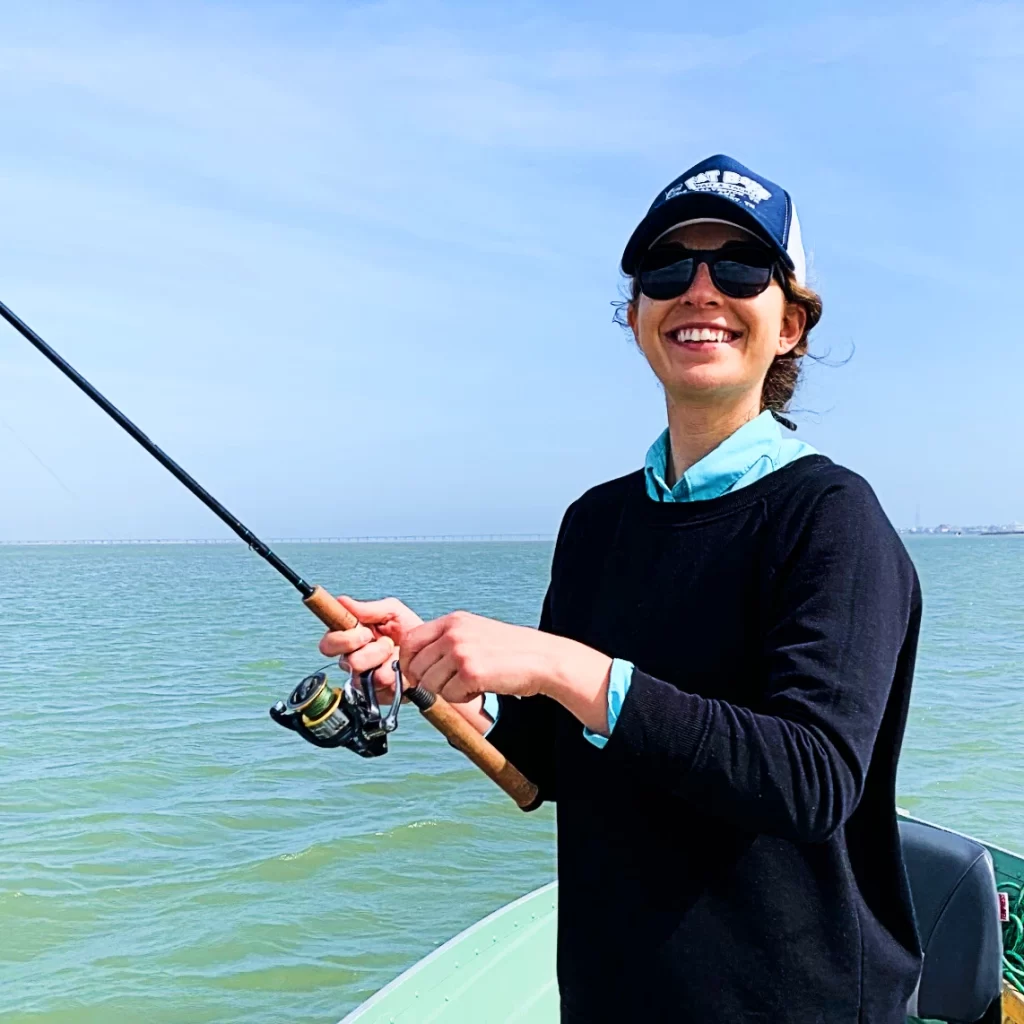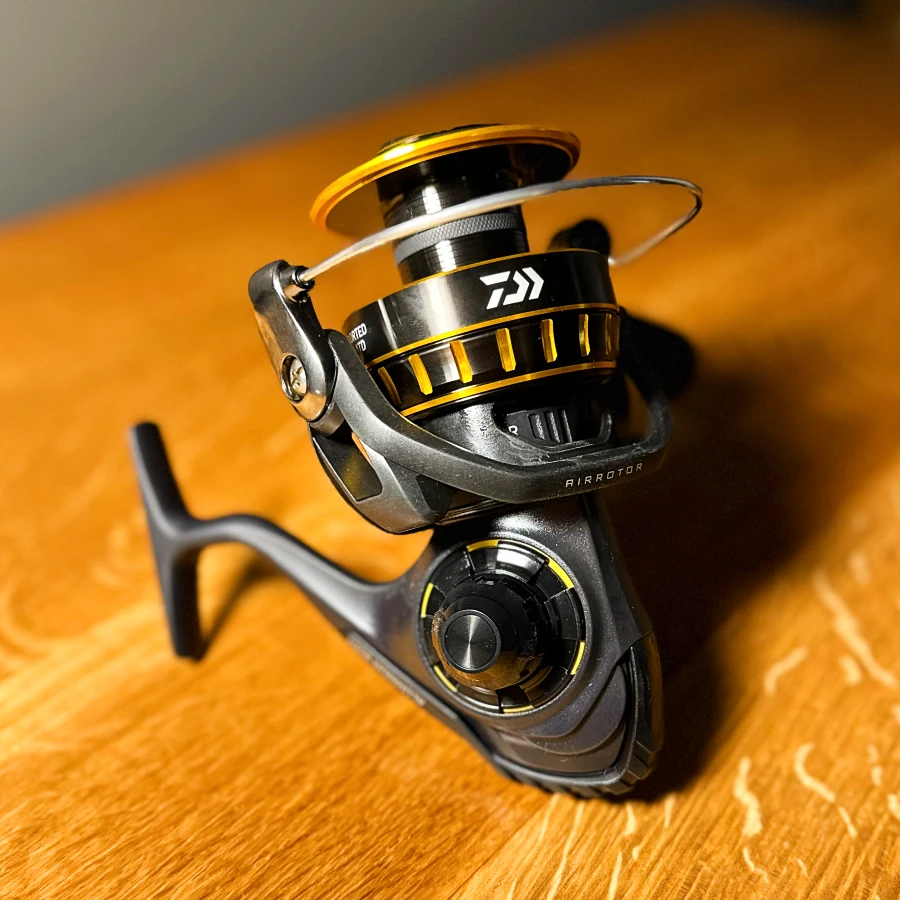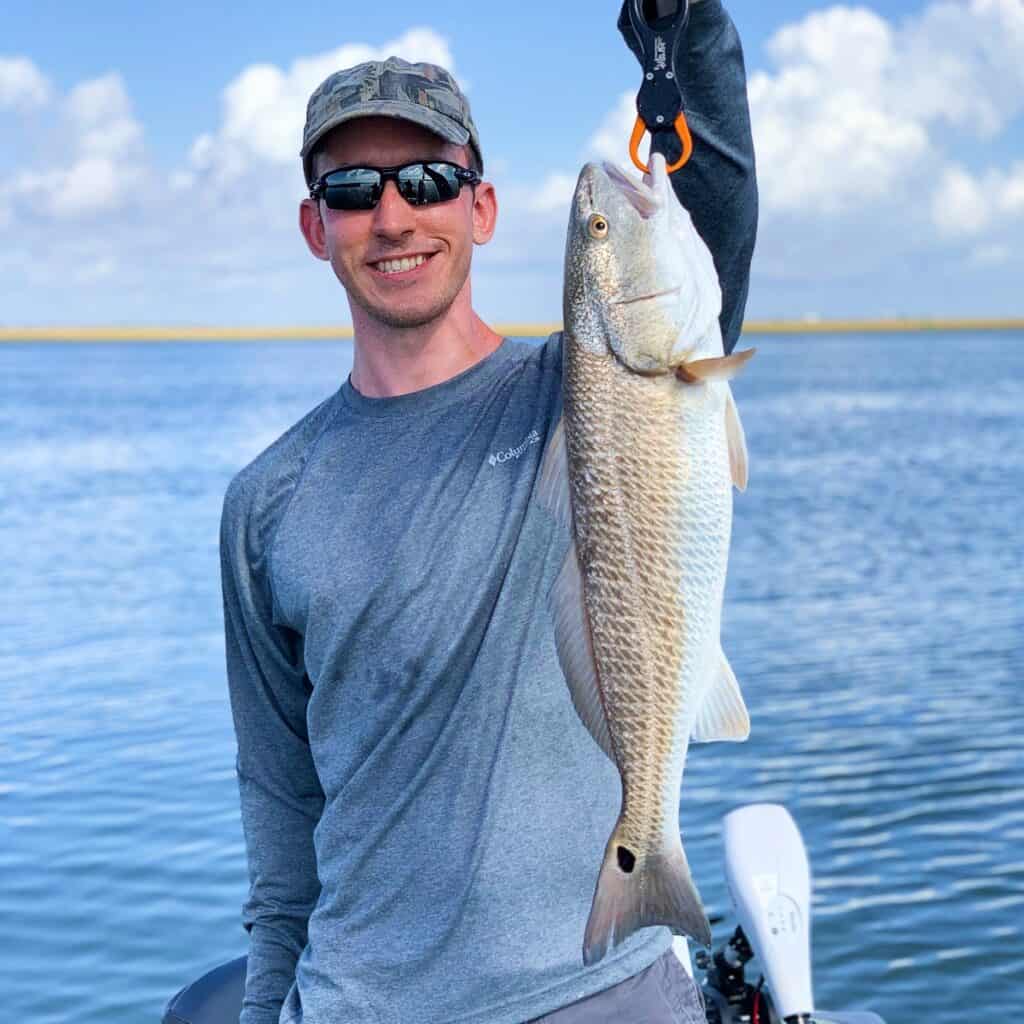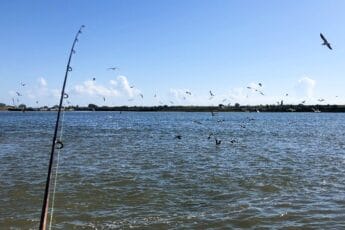
Updated 12/29/2023
Looking for the best saltwater rod and reel combo available on the market today? Look no further. I’ve done the hours of rod and reel research and testing on weight, strength, durability, and materials so you don’t have to.
Rod and reel combos are a great way for beginners or budget sensitive anglers to acquire functional setups that are ready to go right out of the box. Check out our top recommendations by category to have the right equipment for the job.
*Disclosure: I only recommend products I would use myself and all opinions expressed here are my own. This post may contain affiliate links that at no additional cost to you, I may earn a small commission.
Our Top Picks
- Best for the Money: Penn Battle III Spinning Rod & Reel Combo
- Best for Beginners: Ugly Stik Bigwater Spinning Rod & Reel Combo
- Best Under $100: Daiwa D-Wave Saltwater Spinning Rod & Reel Combo
- Best Inshore: Daiwa BG Spinning Rod & Reel Combo
- Best Baitcasting Combo: Abu Garcia Veritas Baitcaster Combo
- Best Heavy Duty: Penn Spinfisher VI Saltwater Rod & Reel Combo
- Best Conventional: Penn Squall II Level Wind Conventional Combo
The Best Saltwater Rod & Reel Combos
Whether you’re a new angler or a grizzled expert, we have you covered. Check out our recommendations for best overall saltwater fishing rod and reel combo as well as budget, beginner, and conventional options!
1. Penn Battle III Spinning Rod & Reel Combo
- Rod Length: 6’6″ to 10′
- Power: Light to Heavy
- Reel Size: 1000 to 8000
- Ball Bearings: 5+1
Pros:
- Wide range of available rod and reel sizes and powers for various applications
- Great value for the price
Our choice for best saltwater rod & reel combo for the money is the Penn Battle III Spinning Rod and Reel Combo which we feel is that perfect mix of premium quality with a manageable price tag. Heck, the Penn Battle III reel is our choice for best saltwater fishing reel so it’s no surprise if you slap it on a decent rod we’ll think highly of it!
The reel was the 2020 ICAST Online Best of Category Winner – Saltwater Reel, includes a 5+1 sealed stainless steel ball bearing system, Penn’s HT-100 carbon fiber drag washers, and a full metal aluminum body and side plate. It is high quality designed for durability and performance and Penn really outdid themselves with the attention to detail.
We recently attended a charity inshore fishing tournament in Galveston where we noticed our guide, Jesse, had Penn Battle III reels on all of his rods. When asked about it, Jesse said he fishes 250 days or more a year in saltwater conditions and does next to nothing to maintain these reels. He’s had no problems with them and loves how reliable they are considering how hard he works them. We even caught a 28″ redfish which placed for biggest fish in the tournament and a 25″ speckled trout on that trip with this reel!
The rod blank is a graphite composite with either cork or eva handle depending on the model. It has plenty of backbone to reel in big saltwater species.
While we generally expect a rod & reel combo to skimp in quality on one of the components, we were pleasantly surprised with this pairing by Penn. This combo is great value for the price.
2. Ugly Stik Bigwater Spinning Rod & Reel Combo
- Rod Length: 6’6″ to 10′
- Power: Medium to Medium-Heavy
- Reel Size: 5000 to 7000
- Ball Bearings: 1+1
Pros:
- Great Warranty (7 years for rod)
- Heavy duty equipment that’s beginner friendly
- Good starting point to try it out (then upgrade reel later)
Our choice for best saltwater fishing rod & reel combo for beginners is the Ugly Stik Bigwater Spinning Rod & Reel Combo. This combo is great for beginners due to its forgiving price point, heavy duty construction, and great rod warranty.
This rod is plenty sturdy. It’s heavier and less sensitive than other similar class rods but is nearly unbreakable! The stainless steel inserts will succumb to saltwater corrosion quicker than pricier alternatives.
The reel is more on the budget end of equipment. We recommend beginners to get this combo, try it out for a bit, then upgrade the reel to a better option (like the Penn Battle III we discuss in item 1).
3. Daiwa D-Wave Saltwater Spinning Rod & Reel Combo
- Rod Length: 7′ to 10′
- Power: Medium
- Reel Size: 4000 to 5000
- Ball Bearings: 1+1
Pros:
- Budget friendly!
Our choice for the best saltwater fishing rod and reel combo under $100 is the Daiwa D-Wave Saltwater Spinning Rod & Reel Combo. This combo is a perfect budget entry point into saltwater fishing without sacrificing quality.
The rod is fiberglass and is heavier than most other choices on this list. That said, it’s plenty strong to reef in huge saltwater fish! Both the rod and reel are rated for saltwater and will have reasonable corrosion resistance. The components at this price point will not be super-high-end so we recommend to take extra care with a freshwater rinse after any fishing excursions to minimize saltwater damage.
Don’t think twice about getting this combo for a budget friendly option!
4. Daiwa BG Spinning Combo
- Rod Length: 7′ to 10′
- Power: Medium-Light to Heavy
- Reel Size: 2500 to 6500
- Ball Bearings: 6+1
Pros:
- Perfect inshore setup
Our choice for the best inshore rod and reel combo is the Daiwa BG spinning rod and reel combo. Daiwa’s BG “black gold” reels set a high standard for quality for the price. This reel is reliable and an exceptional choice for meeting the demands of inshore fishing.
We are partial to the Daiwa BG combo featuring the 4000 size on the 7′ medium-heavy rod. This is a perfect setup to target tailing redfish in the back marshes or chuck a popping cork for a cooler-full of speckled trout.

For more reading, check out our article on the best saltwater spinning reels where we talk about the Daiwa BG reel in more detail.
5. Abu Garcia Veritas Baitcasting Combo
- Rod Length: 7′ to 7’3″
- Power: Medium-Heavy to Heavy
- Reel Size: One Size
- Ball Bearings: 11+1
Pros:
- Great baitcasting combo right out of the box
Our choice for the best saltwater baitcasting rod and reel combo is the Abu Garcia Veritas baitcasting combo.The Veritas is an excellent value proposition for new anglers that balances quality components with a reasonable price point.
The 7’ medium-heavy power Veritas Casting combo is a great value rod and reel at an excellent price point.
The rod blank includes Abu Garcia’s PowerLux 100 which they claim delivers a 15% stronger and 5% lighter rod. The rod has higher end titanium guides and zirconium inserts than we’d expect on a rod of this price point.
We think this rod is a great value proposition for beginners and expert anglers alike looking for a quality saltwater baitcasting rod and reel combo at a decent price.
6. Penn Spinfisher VI Saltwater Rod & Reel Combo
- Rod Length: 6’6″ to 10′
- Power: Medium-Light to Heavy
- Reel Size: 2500 to 8500
- Ball Bearings: 5+1
Pros:
- High quality rod & reel for great price
Our choice for best heavy duty saltwater fishing rod and reel combo is the Penn Spinfisher VI Saltwater Rod & Reel Combo. We like the 7′ heavy version paired with the 7500 as a great all-around heavy duty saltwater fishing combo. Grab the 10′ version for surf fishing. This rod and reel are the top end of available pre-made rod and reel combos.
Penn’s Spinfisher VI is a workhorse surf and offshore fishing reel. Featuring an IPX5 sealed body and spool, full metal body/side plates, and a 5+1 sealed stainless steel bearing system, the Spinfisher VI has great durability and strength. The larger models have incredible max drag capabilities of up to 50 pounds which is more than enough for the largest saltwater species.
The rod is comfortable with a full cork handle and surprisingly good quality as a combo rod. This combo is a great heavy duty option to dip your toes into saltwater fishing. We recommend to grab this combo then later on upgrade the rod to a higher-end choice.
7. Penn Squall II Level Wind Conventional Combo
- Rod Length: 7′ to 9′
- Power: Medium to Heavy
- Reel Size: 20 or 30
- Ball Bearings: 3+1
Pros:
- One-stop-shop conventional setup
Our choice for the best conventional saltwater rod and reel combo is the Penn Squall II Level Wind Conventional Combo. This combo is an excellent budget entry into a fully functional, heavy duty conventional saltwater fishing setup.
The rod blanks are either graphite composite or tubular fiberglass depending on the model. The reel has a sturdy 33 lb drag rating plus a massive line capacity of 650 yards of 30 lb braid.
The reel also features a fast gear access side plate designed to allow anglers to quickly grease and clean their reel.
This combo is a great setup for anything offshore, nearshore, and for trolling without breaking the bank.
Combo Comparison Table
Check out our handy comparison table showing key specifications for our top rod and reel combo choices.
| Combo Name | Rod Length | Power | Reel Size | Ball Bearings |
|---|---|---|---|---|
| Penn Battle III Spinning Rod & Reel Combo | 6’6″ to 10′ | Light to Heavy | 1000 to 8000 | 5+1 |
| Ugly Stik Bigwater Spinning Rod & Reel Combo | 6’6″ to 10′ | Medium to Medium-Heavy | 5000 to 7000 | 1+1 |
| Daiwa D-Wave Saltwater Spinning Rod & Reel Combo | 7′ to 10′ | Medium | 4000 to 5000 | 1+1 |
| Daiwa BG Spinning Combo | 7′ to 10′ | Medium-Light to Heavy | 2500 to 6500 | 6+1 |
| Abu Garcia Veritas Baitcasting Combo | 7′ to 7’3″ | Medium-Heavy to Heavy | One Size | 11+1 |
| Penn Spinfisher VI Saltwater Rod & Reel Combo | 6’6″ to 10′ | Medium-Light to Heavy | 2500 to 8500 | 5+1 |
| Penn Squall II Level Wind Conventional Combo | 7′ to 9′ | Medium to Heavy | 20 or 30 | 3+1 |
Conclusion
Saltwater fishing rod and reel combos are a great one-stop-shop way to get into saltwater fishing for a reasonable price. Generally, combos will have either a lower quality rod or reel to keep the manufacturing cost down. This doesn’t mean rod and reel combos aren’t a solid option.
We recommend newer anglers grab a combo with a solid reel (like our top choice Penn Battle III Spinning Rod & Reel Combo) then upgrade the rod later.
Check out our articles for great rods to pair with these reels when it’s time to upgrade:
- Best Saltwater Fishing Rods
- Best Inshore Fishing Rods
- Best Rods for Redfish and Speckled Trout
- Best Mahi Mahi Rods
- Best Flounder Rods
- Best Sheepshead Rods
- Best Trolling Rods
- Best Surf Fishing Rods
- Best Pier Fishing Rods
Check out our articles for great reels to pair with these rods when it’s time to upgrade:
- Best Saltwater Reels
- Best Inshore Reels
- Best Surf Fishing Reels
- Best Conventional Reels
- Best Saltwater Baitcasting Reels
- Best Saltwater Spinning Reels
- Best Reels for Redfish and Speckled Trout
- Best Flounder Reels
How to Choose The Best Saltwater Rod & Reel Combo For You
Choosing the best saltwater rod & reel combo should account for factors like rod size, power, action, and materials plus reel size, line capacity, and drag capabilities.
Rod Length
Saltwater anglers should pick rod length based on what type of fish they are after and what kind of fishing they intend to do. Generally, longer rods can cast further, and shorter rods are easier to maneuver, cast accurately, and are sturdier.
Inshore saltwater anglers should pick a rod around 7 feet long. This is a great length to be able to cast relatively far but still have the accuracy to pinpoint cast to a specific spot.
Surf fishing off the beach requires long distances casts so most surf rods are over 10 feet long. A rod between 10 to 12 feet is a great option for surf saltwater fishing.
Rod Power
Rod power is the fishing industry’s terminology for rod stiffness. Rod powers range from ultralight to heavy. Medium power is a great all around choice for saltwater fishing.
Saltwater species are generally larger and stronger fighters than many freshwater species, so we recommend rods from medium to heavy for saltwater surf fishing. If targeting huge species like bull reds or sharks, size up to a heavy rod. If targeting reds, speckled trout, or striped bass size fish, medium power is perfect.
Rod Action
Rod action refers to how far down the rod will bend when pressure is applied to the tip. Rod actions range from extra-fast (bends near tip) to slow (nearly the whole rod bends).

The faster the action, the more sensitive the rod will feel. The slower the action, the more casting distance you can get (the rod will feel like it whips more when you cast).
Saltwater rods with moderate to fast actions are ideal. They provide a balance of accurate casting and sensitivity.
Portability
Another key factor to picking the best saltwater fishing rod and reel combo is portability.
Seven foot long rods fit in most vehicles and boat rod holders. Much longer and you may run into problems. Make sure you check if your rod can fit in your vehicle before you make a purchase!
Think about purchasing multi-piece ‘travel’ versions of rods and/or look into travel cases to help protect your rod during transport. There’s nothing worse than accidentally breaking a guide or the rod tip on the way to the beach, jetty, pier, or boat launch.
Handle Material
Rod handle feel is an important factor to consider when picking a saltwater fishing rod. Common handle types are rubber shrink tube, cork tape, or neoprene. Rubber shrink is usually considered a more budget option, whereas cork or neoprene feels better to grip and handle.
Rod Guide Material
Rod guide material is important because lower quality materials are heavier and will rust quicker and could potentially fail. This can be partially avoided by rinsing rod guides with freshwater after every trip.
The highest end rods have titanium or silicone carbide (SiC) rod guides whereas middle end or budget rods will have some variation of aluminum oxide or stainless steel.
Higher end rod guides are made with lighter materials with lower friction that will either rust slower or not at all. Less expensive rod guides are heavier and will succumb to the elements more quickly.
For additional information on rod guide considerations, check out our article that explains fishing rod guides in detail.
Rod Material
Rod material affects how rod strength and how it deforms during casting or reeling in a fish. Common rod materials are graphite, fiberglass, and composite. Check out our deep dive on rod blanks for more information.
Graphite
Graphite rods have incredible sensitivity in lightweight packages. They are great for detecting subtle fish strikes. Graphite rod disadvantages are that the rods can be a little weaker than the other options and more susceptible to breakage, especially around nicks or scratches.
Fiberglass
Fiberglass is strong, durable and flexible but weighs more than graphite. They are less sensitive than the other types of rod materials.
Composite
Composite rod materials are a mix of graphite and fiberglass that seek to have the light weight and sensitivity of graphite rods with the strength of fiberglass rods.
Reel Seat
Reel seats are the component where the fishing reel is secured onto the fishing rod by tightening a locking nut. The basic parts of a reel seat are the body, hood, locking nut, and barrel threads. Common reel seat materials are either graphite or aluminum which are both lightweight, corrosion resistant materials. Reel seats are sized to match the power of the rod. For example, a reel seat on an ultralight fishing rod won’t fit a massive 10000 size spinning reel.
Most freshwater applications utilize fully graphite reel seats due to graphite’s light weight. For heavier duty saltwater applications, reel seats are commonly upgraded to machine-grade aluminum for increased strength. For targeting the largest fish on the planet, the complete rod butt and reel seat can be aluminum for maximum strength.
Reel Line Capacity
Line capacity refers to how much fishing line fits on the reel. The total spool capacity is specified by mono vs braid and line strength as pound test. An example line capacity would be “200 yards of 20-pound test braid”.
Braid is smaller diameter than mono at the same line strength which means you can fit more braid on a reel. Also, higher pound test line is larger diameter and will take up more space on the reel spool.
Since saltwater fishing can require long casting distances and large diameter line, line capacity is an important consideration. When I pick a saltwater reel, I make sure it can fit 200+ yards of braid at the strength I want. I usually put 15-30 lb braid on my inshore reels and 20-40 lb braid on my surf reels. Some people will size up to 80+ pound test if targeting huge species like sharks.
Reel Ball Bearings
Ball bearings in fishing reels are small, spherical bearings that reduce friction and increase smoothness of a reel’s operation. They are located within the internal mechanism of the reel and allow the reel’s moving parts to rotate smoothly against each other.
Most quality reels have at least four ball bearings. More ball bearings is usually better because the higher the number of ball bearings, the more friction is reduced and less wear and tear on the internal reel components. That said, ball bearing quality and material choice is also important. I would rather have four high-quality ball bearings than ten low quality bearings.
Most ball bearings are stainless steel but can also be ceramic. Many reels list something like “5+1 bearings” – this reel would be five ball bearings plus one roller bearing.
Reel Drag System
Drag systems on fishing reels provide resistance to the spool as line is retrieved. A loose drag makes it easier for the spool to spin freely and a tight drag makes it difficult to rotate the spool.
Drag systems work using a series of washers or disks pressed together by a drag knob or level (usually on the top of spinning reels). As the drag is tightened, the drag washers are pressed together which increases resistance on the spool. Drag should be set to match the strength and size of the target fish species.
Setting the drag properly is an art. You want the drag tight enough to reel in the fish, but not tight enough where a strong pull could snap your line or cause your fishing knot to fail. When the drag is properly set, a strong pull from a fish should be able to pull some line from your reel.
Pro tip for setting drag when saltwater fishing – if you place your rod in a rod holder, drastically loosen the drag. If the drag is tight, a big fish could pull your whole rig into the water! Not a good day!
Reel Gear Ratio
The gear ratio on a fishing reel refers to the relationship between the number of turns on the spool for every turn of the handle. For example, a gear ratio of 5:1 means the spool rotates five times for every turn of the handle.
Gear ratio is an important consideration when selecting a fishing reel because it affects the speed at which you can retrieve your line. A higher gear ratio is better for situations where you need to reel long distances or require fast bait presentations. A lower gear ratio is preferred for situations where a lower retrieval rate is desired, like when using finesse techniques.
Most reels have a gear ratio between 4:1 to 7:1. Many medium size reels are around 6.2:1 gear ratio which is a great for most applications.
Reel Material Quality
Material quality is an important consideration for picking a saltwater reel. Fishing reels are typically made of a combination of metal, rubber, and plastic parts. The body of the reel is usually made of aluminum or another type of metal to provide strength and durability. Plastic is used for many of the peripheral parts like the handle or drag knob because it is lightweight and corrosion-resistant.
Rubber seals may be used to protect against water, dirt, and sand ingress. High-end reels may have ceramic bearings or higher quality metal components.
Look for reels made of high-quality materials with solid, durable construction.
Reel Brakes
Baitcasting reels have reel brakes. When you make a cast with a baitcasting reel, the momentum of the bait pulls line off of the spool. The spool rotates fastest at the beginning of the cast when forces are the highest. The reel brake slows down rotation of the spool to keep the fishing line tight on the spool and stop a backlash mess.
Brakes are important because if the spool rotates faster than the speed your bait is pulling out line, your reel will become a huge backlash mess.
Saltwater Rod & Reel Combo Frequently Asked Questions
What type of rod is best for saltwater fishing?
The best rod for saltwater fishing depends on what type of fishing the angler intends to do. For inshore fishing, a 7′, medium power rod is a great all-around choice for targeting redfish, flounder, speckled trout, or striped bass.
The best rod for surf fishing for most people is a 10 to 12 foot surf spinning rod with medium to medium-heavy power and moderate to fast action. This type of rod can cast far enough to reach the current troughs in the surf that fish frequent, and have enough backbone to reel in big surf species.
What reel to pair with saltwater fishing rod?
Since most anglers looking for rod and reel combos are just starting out, we recommend focusing on spinning reels because they are more beginner friendly and can do any fishing technique needed.
Saltwater fishing rods should be paired with saltwater rated reels. Saltwater fishing reels are built with corrosion resistant parts and hold up much better to the corrosive salty conditions. A 4000 size spinning reel is a great all around choice for common species like redfish, speckled trout, flounder, and striped bass. Size up to 8000 or larger for offshore or surf fishing for species like bull reds, sharks, and grouper.
Be sure to thoroughly clean your equipment after surf fishing with a gentle freshwater rinse. Sand and salt spray gets in everything and your gear will last longer if you spray it down after each outing.
What is the best length saltwater rod and reel combo?
The best length saltwater rod and reel combo is 7′ for multi-purpose inshore and boat fishing. For surf, pier, or jetty fishing, 10-12′ is ideal because the longer rod length allows for long distance casting.
How many yards of line do you need for a saltwater rod and reel combo?
Saltwater rods and reels preferably have 200 yards of line. You want plenty of line to make long casts. Also, large fish may pull a bunch of line if they make a run for it. Swapping from mono to braid can help with this because braid has a smaller diameter meaning you can fit more on the reel spool.
Is mono or braid better for saltwater fishing?
Braided fishing line is preferable for saltwater fishing. Braided line has significantly smaller diameter for the same strength line when compared to mono. This can be key while saltwater fishing because wind and waves will constantly pull at your line. The smaller diameter means less effect from the elements.

Written By: Andrew Juran
Andrew is a seasoned angler with over 25 years of experience fishing across the United States. He has caught hundreds of saltwater fish using various techniques and mentored many in the art of fishing. An advocate for sustainable fishing, Andrew is an active member of the Coastal Conservation Association, an organization committed to marine conservation.
For frequent fishing tips, behind-the-scenes looks, and real-time catches, connect with Andrew on Instagram











